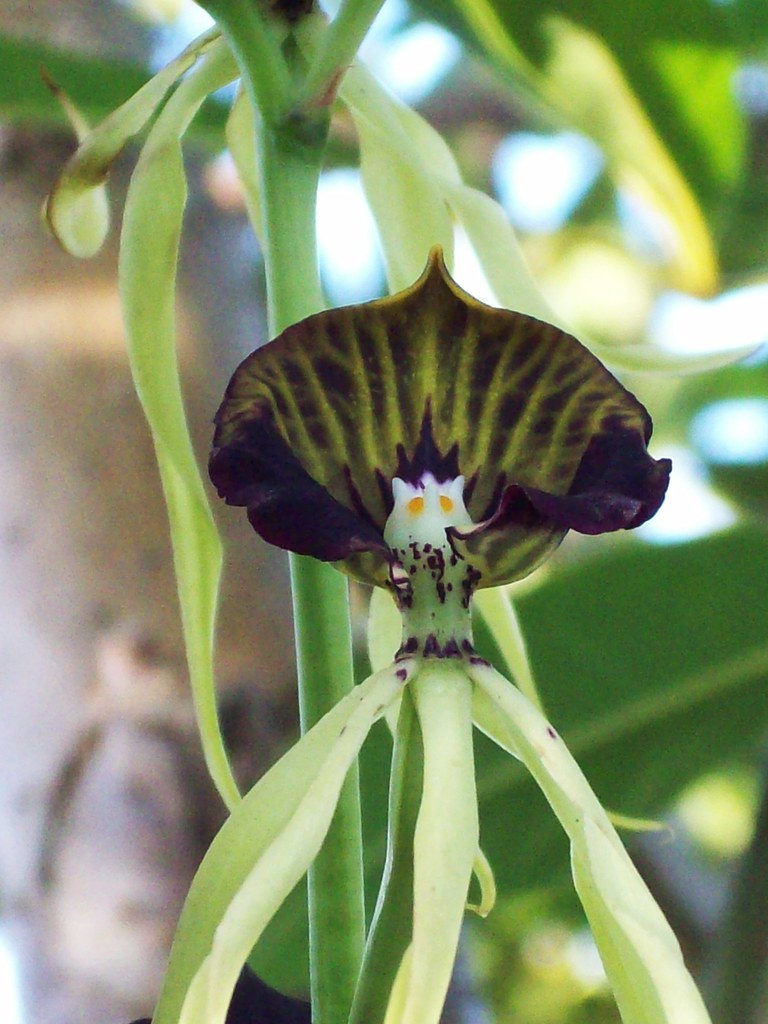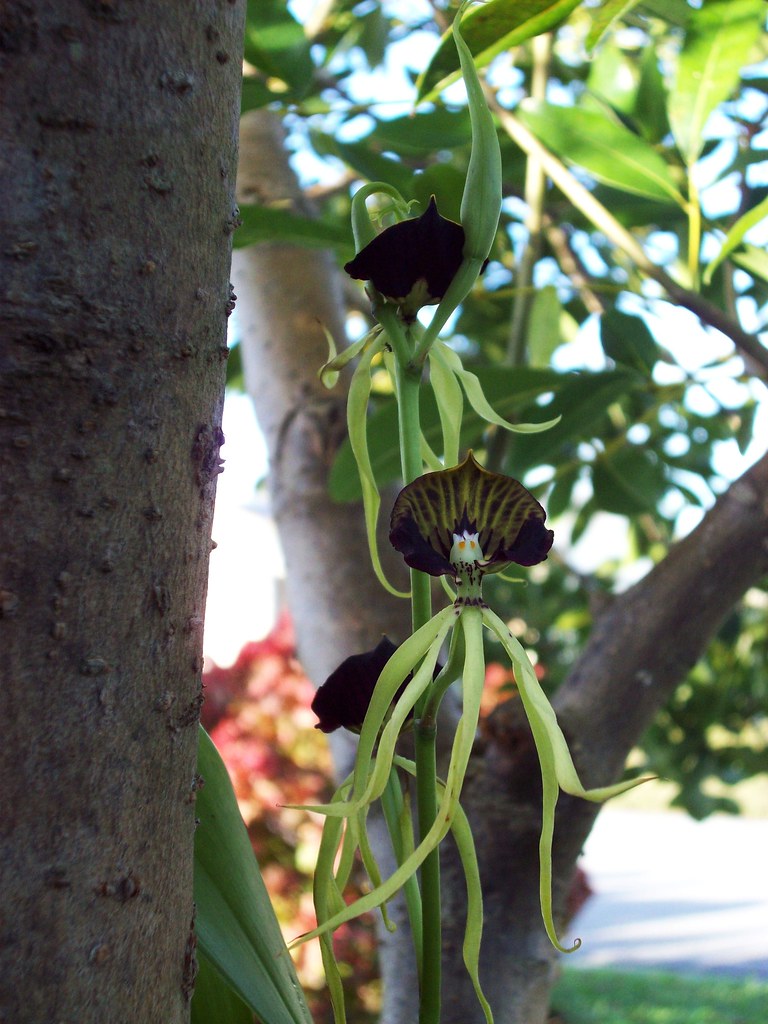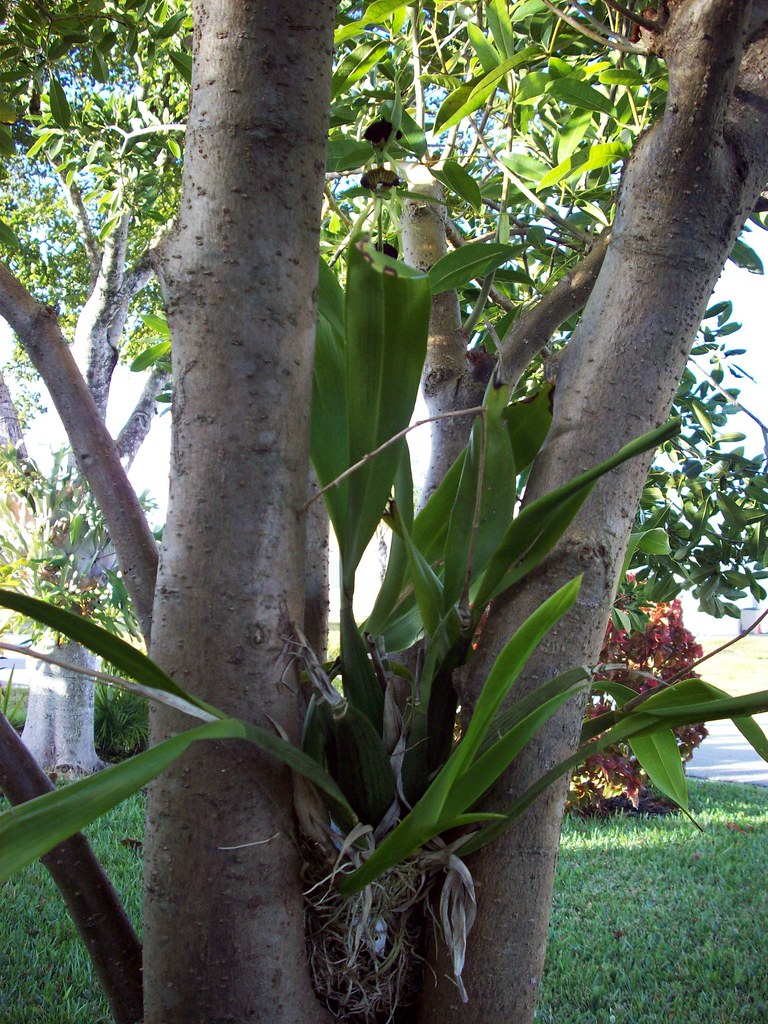Well, after little more than a year, I have my first Musa 'Ae Ae' fruits. As you can see the fruits share the same beautiful variegation that the leaves, petioles, and trunk have. I have not tasted the Ae Ae fruits yet, but I hear they are creamy and delicious. I am looking forward to tasting them. Without further ado here are those pictures of my Ae Ae fruits!
Monday, December 19, 2011
Ae Ae Fruits
Posted by Eric Bronson at 12:01 PM 4 comments
Labels: musaceae, tropical fruits
Monday, August 8, 2011
Musa 'Ae Ae'
Last year my friend Jordan Steele of Coral Gables, gave me a pup of the most extraordinary banana the 'Ae Ae'. The Ae Ae banana is a beautiful banana plant; with variegated leaves, petioles and fruits it is simply amazing. Here are some pictures for you to enjoy and more information about this specimen.
Family: Musaceae •
Genus: Musa •
Species: 'Ae Ae' •
Country of Origin: Hawaii •
Synonyms: Sacred Banana, Koae, Hawaiian Variegated, Koa'e, Manini •
Common Names: Ae Ae •
According to Bananas.org's Wiki, A'e A'e means 'hair prematurely graying". No one knows where the Ae Ae was first found as Hawaii has no native bananas. They may have gotten the Ae Ae the same way we did, from the East. It's been in south Florida for 50 years, according to Mr. Steele (Banana's.org Wiki, 2001).
Some have found it a challenge to grow, but I have had amazing growth in just one year. I received mine from Jordan on August 30, 2010 here is a picture of me with the little pup on his website My Ae Ae's Brother As you can see, in less than a year I have a twenty foot plant with numerous pups.
My whole backyard is mulch now and it has really helped with growth. I gave it supplemental water through winter and left on all the dead leaves for added insulation. Grows well outside here in South Florida in full morning to midday sun, with heavy mulching, minimal supplemental watering and no fertilizer to date. Here is more cultural information from Banana's.org:
More information can be found about this variety and others at Bananas.orgGrows well in moderate to high humidity. Will get brown spots in low humidity. Does well under artificial lighting (standard fluorescent grow lighting). Likes to be watered regularly. Feed heavily (10-10-10) to keep green to white balance. Higher nitrogen helps to maintain greener leafs. It's been stated that Ae Ae like acid soil, but this plant has been grown successfully in highly alkaline soil and water conditions (7.0pH in Las Vegas, NV US)[Author's note 8.2pH here in South Florida]. Appears to be less susceptible to root and corm rot in higher pH. Likes a very light and well-drained soil if grown in pots. Due to its mature height, needs good ceiling clearances if grown indoors. In dry climates this plant has not demonstrated any of the difficulties that other growers in higher humidity climates have discussed. Needs lots of sun protection as the white area of each leaf will burn very easily. Does not like higher temps but has shown survivability in temps well over 105° F in a Mediterranean climate (Banana's.org Wiki, 2001).
Sources:
Banana's.org Wiki, . (2001, August 3). Musa 'ae ae'. Retrieved from http://www.bananas.org /wiki/Musa_%27Ae_Ae%27
Steele, J. (n.d.). My ae ae's brother. Retrieved from http://togofcoralgables.com/MyAeAesBrother.aspx

Musa 'Ae Ae' by Eric Bronson is licensed under a Creative Commons Attribution-Noncommercial-No Derivative Works 3.0 United States License.
Posted by Eric Bronson at 12:30 PM 3 comments
Labels: musaceae, tropical fruits
Thursday, June 30, 2011
TREC Mango Bonanza
I was at TREC Tropical Research and Education Center (University of Florida) in Homestead, Tuesday with my friend Michelle. Our friend Ian gave us a tour of the grounds and fruit tree collections. He also sent us home with a few mangoes, heh-he. You WON'T find these varieties at Publix; I hate those bland things! There are many mango cultivars to choose from each unique in flavor. I recommend you try them all. Fairchild has their Mango fest on July 9, 2011 Mango Festival at Fairchild they have an extensive tasting table where you can explore all the different flavors mangoes have to offer.....They also sell trees, chutneys and jams etc. If your in the area do yourself a favor and stop in.
Posted by Eric Bronson at 10:51 AM 0 comments
Labels: anacardiaceae, tropical fruits
Thursday, June 23, 2011
Question
What would you think about being able to grow your own vegetables and fruits? Enough where you wouldn't have to purchase these items from the store? (unless of course you insist on eating veggies & fruits that are out of season) Maybe even your own eggs and tillapia? Comments please?
Posted by Eric Bronson at 11:09 AM 0 comments
Labels: diy, sustainable
Tuesday, June 7, 2011
Black Swallowtail
Family: Papilionidae •
Genus: Papilio •
Species: polyxenes •
Range: North America •
Synonyms: n/a •
Common Names: Black Swallowtail •
Look at this handsome devil that showed up in my yard last week. One of the many butterflies I see in my yard from time to time. Click HERE for some earlier posts on butterflies. Here is a little more information about the Black Swallowtail butterfly courtesy of the University of Florida.
The caterpillar of the black swallowtail is 1-1/2" to 2" long, often called the "parsley worm" because it forages on parsley and other umbelliferous plants (carrot, wild carrot, dill, celery, fennel, etc.). Mature larvae are green with black and yellow spots or markings on each segment.
The black swallowtail butterfly, also known as the American or parsnip swallowtail, has a wingspan of 2-1/2" to 3-1/2". The upper surface of the forewings has two parallel rows of yellow submarginal spots that contrast with the basal black color of the wings. These spots also appear on the hindwings, but with a curving row of blue spots between the rows of yellow (Castner, 2007).
Sources: Castner, J.L. (2007, July 1). Florida butterflies sheet 2. Retrieved from http://edis.ifas.ufl.edu/in032

Black Swallowtail by Eric Bronson is licensed under a Creative Commons Attribution-Noncommercial-No Derivative Works 3.0 United States License.
Posted by Eric Bronson at 2:11 PM 1 comments
Labels: butterfly, papilionidae
Saturday, May 21, 2011
Amorphophallus bulbifer 2011
Family: Araceae •
Genus: Amorphophallus •
Species: bulbifer (Schott) Blume (1837)•
Country of Origin: India •
Synonyms:Arum bulbiferum Roxb.•
Common Names: Voodoo Lily, Devil's Tongue, Corpse Flower •
A. bulbifer is one of my prized Amorphophallus species. I found this little stinker by its stench this morning! This flower smells like rotting flesh and sulfur to attract its pollinator; flies, beetles and other insects. What you see above is the flower. Like most aroids it is composed of a spathe which usually envelops the spadix a flower spike with a fleshy axis. One interesting thing about most Amorphophallus is that they produce one single leaf, which you can see in my previous post Amorphophallus bulbifer. I know it looks like many leaves but I assure you botanically speaking it is a single leaf. This species has a deep green leaf with pink margins. The leaf will sometimes grows bubils in its axis which it uses for asexual reproduction. This trait was incorporated into its species name bulbifer. It also has an amazing looking stem almost reptilian or alien in appearance. The leaf will die off after some time usually after summer; at which time the plant will go dormant. During this period, which fortunately enough for me coincides with our dry season, I withhold all water to prevent fungal activity. After one or two years of vegetative growth you are rewarded with a beautiful and unusual flower as seen above! A. bulbifer is easy to grow and I grow this plant in a moist medium consisting of peat moss, vermiculite, and sand; in full morning sunlight (50-75%). I often have bubils and seeds for sale; contact me if you are interested and I will put you on my waiting list.
Sources: Amorphophallus. (2011, April 13). Retrieved from http://en.wikipedia.org/wiki/Amorphophallus

Amorphophallus bulbifer 2011 by Eric Bronson is licensed under a Creative Commons Attribution-Noncommercial-No Derivative Works 3.0 United States License.
Posted by Eric Bronson at 10:20 AM 0 comments
Thursday, May 19, 2011
Clathrus ruber
Invasion of the Body Snatchers!! These have been popping up all over my yard this year, probably due to all the mulch I have added over the last year. I thought I had a dead critter in the yard but it turns out it was this stinky son-of-a-gun!
Genus:Clathrus •
Species:ruber •
Country of Origin: Northern Africa, Asia, Australia, and North and South America •
Synonyms: Clathrus flavescens Pers. (1801) Clathrus cancellatus Tourn. ex Fr. (1823)
Clathrus nicaeensis Barla (1879) Clathrus ruber var. flavescens (Pers.) Quadr. & Lunghini (1990) •
Common Names: Latticed Stinkhorn, Basket Stinkhorn, Red Cage •
Clathrus ruber is a species of fungus in the stinkhorn family, and the type species of the genus Clathrus. It is commonly known as the latticed stinkhorn, the basket stinkhorn, or the red cage, alluding to the striking fruit bodies that are shaped somewhat like a round or oval hollow sphere with interlaced or latticed branches. The fungus is saprobic, feeding off decaying woody plant material, and is usually found alone or in groups in leaf litter on garden soil, grassy places, or on wood-chip garden mulches ("Clathrus ruber," 2011)
The fruit body initially appears like a whitish "egg" attached to the ground at the base by cords called rhizomorphs. The egg has a delicate, leathery outer membrane enclosing the compressed lattice that surrounds a layer of olive-green spore-bearing slime called the gleba, which contains high levels of calcium that help protect the developing fruit body during development. As the egg ruptures and the fruit body expands, the gleba is carried upward on the inner surfaces of the spongy lattice, and the egg membrane remains as a volva around the base of the structure. The fruit body can reach heights of up to 20 cm (7.9 in). The color of the fruit body, which can range from pink to orange to red, results primarily from the carotenoid pigments lycopene and beta-carotene. The gleba has a fetid odor, somewhat like rotting meat, which attracts flies and other insects to help disperse its spores ("Clathrus ruber," 2011)
Since the appearance of these indicates excellent microbial activity, I'm thrilled about them popping up even if they do stink!
Sources:Clathrus ruber. (2011, March 17). Retrieved from http://en.wikipedia.org/wiki/Clathrus_ruber

Posted by Eric Bronson at 10:06 AM 2 comments
Labels: fungi, phallaceae
Wednesday, March 9, 2011
Bamboo Solitary Bee House
I was inspired by my friends at the Texas Rare Fruit Growers tech.groups.yahoo.com/group/txrarefruitgrowers/ to start using my old bamboo to make houses for our native solitary bees ie: carpenter bees (Xylocopa spp. & Ceratina spp.) and leaf-cutter bees (Megachilidae spp.) We have quite a few native solitary bees here in Florida. I'm hoping they'll use these tubes as their home! We also have orchid bees (Euglossa viridissima) here now and I know they are solitary bees. I wonder if they will use these houses too? The leaf-cutter bees are good pollinators so I'm encouraging them to live in my yard. Here is how I'm making my solitary bee houses. I used some of my old bamboo canes to make the individual "homes" I cut them into 8" lengths and used cotton string to bundle them together, I'm trying to keep thing natural. I also cleaned up the entrance to the home by hand with a countersink tool. I then tied the houses to another larger piece of bamboo. I've angled the bundle down so the houses don't hold water they need to stay dry. I'll mount them in the yard as soon as I acquire the other parts I want to use! I hope to have pictures of my finished product and inhabited nests real soon!
Here are more articles on ways to construct your bee house using different kinds of materials that may more readily available in your area
Nests for Native Bees pdf - http://www.xerces.org/wp-content/uploads/2008/10/nest_factsheet1.pdf
Easy to build “Bee Condo” for native bees! - http://www.fs.fed.us/wildflowers/pollinators/beebox.shtml
Make a Solitary Bee House - http://www.foxleas.com/bee_house.htm


Bamboo Solitary Bee House by Eric Bronson is licensed under a Creative Commons Attribution-Noncommercial-No Derivative Works 3.0 United States License.
Based on a work at www.flickr.com
Posted by Eric Bronson at 12:04 PM 0 comments
Labels: bamboo solitary bee house
Saturday, January 8, 2011
Prosthechea cochleata var. triandra




Family: Orchidaceae •
Genus: Prosthechea •
Species: cochleata var. triandra (Ames) •
Country of Origin: Native to Florida •
Common Names: Cockleshell Orchid, Clamshell Orchid •
This is one of the orchids I'm naturalizing on a tree outdoors, since it is a native to Florida it won't have any problem getting adjusted. As you can see it is already flowering. It has very unusual flowers with a modified lip and twisted hanging petals and sepals. Now that it is established I won't give it any extra care it will flourish on its own. It should form a nice clump. Unfortunately, this species is endangered in Florida(1) due to over-development and habitat loss.
This specimen was purchased from a reputable dealer not collected in the wild. Zones 9-11
P. cochleata is an epiphytic orchid found growing attached to trees in swamps throughout Central America, the West Indies, Colombia, Venezuela, and southern Florida. In Florida, where P. cochleata is listed as endangered, many wild individuals of this species are of a variation that has three anthers, which contain masses of pollen. In most of its range, P. cochleata commonly has only one anther. This has led some taxonomists to conclude that individuals of P. cochleata in Florida may all be descended from a single plant, whose tiny seed may have been transported there by a storm or a bird.(2)
Plants to 60 cm. Stems: pseudobulbs slightly spaced, ovoid to ellipsoid, usually elongate, flattened, 3–15 × 1–3.5 cm. Leaves 1–3, oblong-lanceolate to linear-lanceolate, 5–40 × 1–6 cm. Inflorescences racemes, rarely paniculate, pedunculate, elongate, loosely few-flowered, to 45 cm, base with 1 or 2 spathes. Flowers not resupinate, successive, usually 3–4 open at a time, sometimes with capsules present, green to yellowish green with a few purplish spots near base; sepals and petals similar, hanging, twisted, linear-lanceolate, 25–35 × 3–6 mm; lip deep purple, orbiculate-cordate, concave, 1.2–2.3 × 1.5–3 mm, base whitish marked with conspicuous purple veins, calli 2, yellowish, cushionlike, apex sharply mucronate; anthers 3, middle anther with 4 pollinia, laterals with 2 each, orange; column short, stout, 6–10 mm, apex 5-toothed. Capsules 2–4 × 0.8–1.5 cm.
Flowering Oct--Mar; fruiting Nov--May. In hammocks and cypress swamps, on trees and rocks; 0--30 m; Fla.
The autogamous, 3-anthered Prosthechea cochleata var. triandra is the only variety found in Florida (Broward, Collier, Miami-Dade, Lee, Martin, Monroe counties, and Florida Keys), probably because of the absence of a pollinator. Throughout the rest of the distribution of the species, 3-anthered, abnormal individuals seldom occur, and no populations have been reported. The 1-anthered var. cochleata occurs in Mexico, West Indies, Central America, and northern South America.(3)
(1) http://florida.plantatlas.usf.edu/Plant.aspx?id=2720
(2) http://www.usbg.gov/plant-collections/conservation/Encyclia-cochleata.cfm
(3) http://www.efloras.org/florataxon.aspx?flora_id=1&taxon_id=242102289

Prosthechea cochleata var. triandra by Eric Bronson is licensed under a Creative Commons Attribution-Noncommercial-No Derivative Works 3.0 United States License.
Based on a work at www.flickr.com
Posted by Eric Bronson at 7:35 AM 0 comments
Labels: orchidaceae, orchids


























